2024 Annual Report
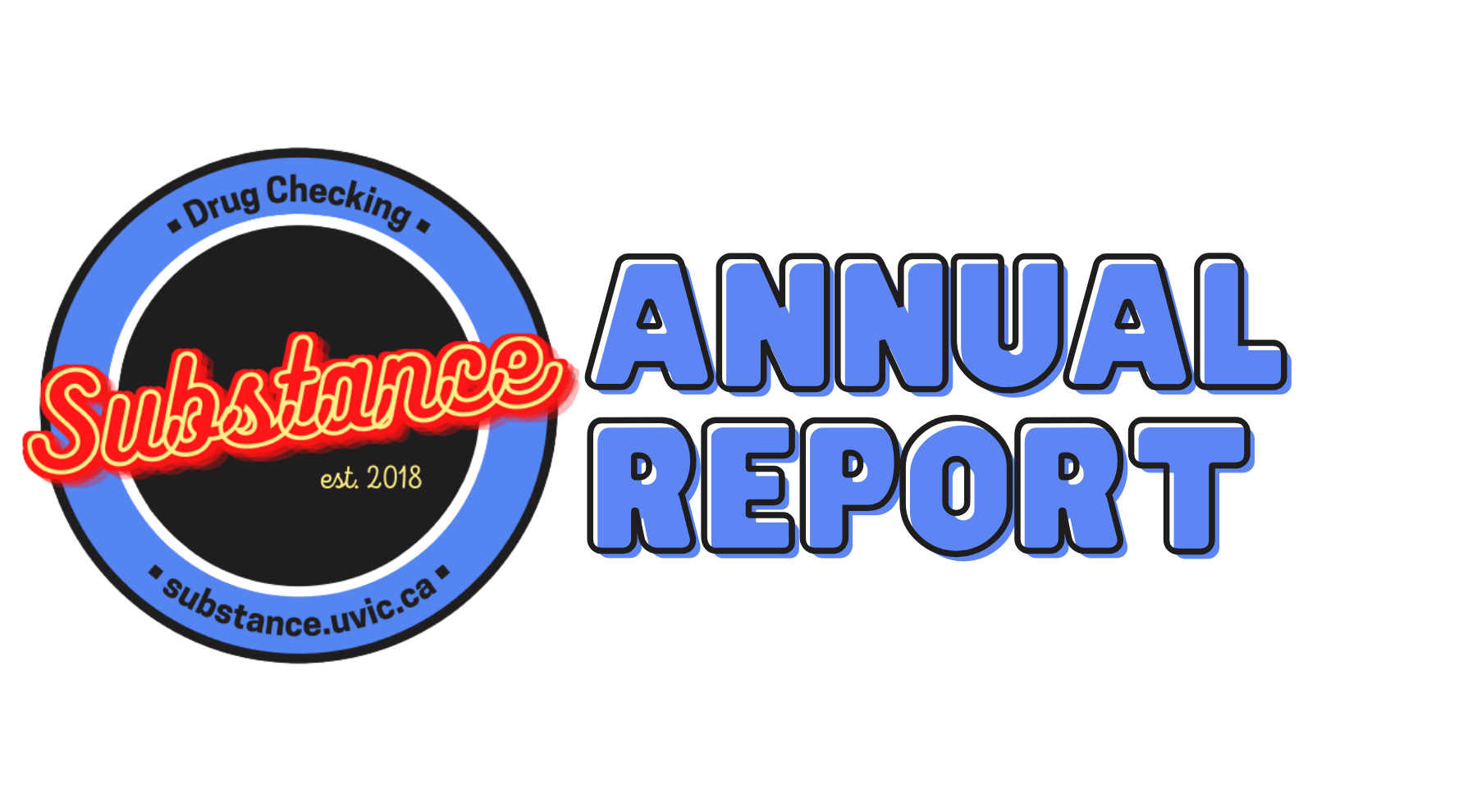
Land Acknowledgement
Our project works on Indigenous land. We provide drug checking, harm reduction education and support across many territories on what is colonially known as “Vancouver Island." We also act as a resource for these services across the province colonially known as “British Columbia." We honour and offer respect to many Nations for their stewardship, care and leadership on these lands. Our project originated on the territories of the lək̓ʷəŋən speaking Peoples, including the Songhees and Xwsepsum (Esquimalt) Nations, and the W̱SÁNEĆ (Saanich) Nations on whose land the University of Victoria is located. Some of the territories we are honoured to work across specifically include: Halalt, Lyackson, Meluxulh (Malahat), Puneluxutth’, Quw’utsun, Stz-uminus, and Ts’uubaa-asatx; Hupačasath and Tseshaht; K’ómoks; Laich-kwil-tach; and Gwa’Sala-’Nakwaxda’xw. We acknowledge the inextricable links between research, colonization and racism against Indigenous Peoples, which continue to this date. Ending the violence faced by people who use drugs cannot be achieved without actively working on decolonization. We also recognize that as the majority of our staff are not Indigenous there is much more work for us to do to challenge the settler lens and colonial framework. This includes learning and growing relationships in order to take an anti-colonial and inclusive approach to the work we do.
Setting the Foundation Towards Indigenous and Decolonial Drug Checking
Written by Sarah Littlechild, Ermineskin Cree Nation
At its core, decolonial and Indigenous centered harm reduction is about resisting against and reducing the harms of colonialism by (re)connecting back with our ancestral and cultural ways of being, knowing, and doing as First Nations, Inuit, and Metis Peoples. Although many Indigenous Nations, communities, and organizations have taken on this work, utilizing their own culturally specific wisdoms and approaches often alongside western harm reduction methods tai- lored to the needs of their peoples, drug checking specifically has not yet been explored in these ways. This is needed now more than ever before, as Indigenous Peoples continue to experience greater harms associated with illicit sub- stance use in society, and drug checking can be a possible tool – in addition to culture – to support self-defined wellness. As a nêhiyaw/Ukrainian service provider and academic working alongside the Substance Drug Checking project, I was privileged throughout 2024 to begin (re)conceptualizing possibilities for drug checking through Indigenous, culturally centered, and decolonial worldviews, practices and settings.
This work started (and has continued) through building relationships with Indigenous service providers and community members. The involvement of Substance at Indigenous and cultural events in 2024, such as with the Victoria Native Friendship Center and QomQem Coastal Connections, allowed us as to begin visioning for what decolonial and Indigenous centered drug checking could mean, how it could look, and what it could feel like. Within many of these spaces, Substance has provided drug checking, together with cultural resources like plant medicine bundles, alongside Indigenous-led organizations which provided access to Elders and Knowledge Keepers, drummers, singers, food, and ceremony. Through the personal experiences, reflections, and team conversations that were born from these shared events, combined with my own cultural knowledge as a nêhiyaw iskwew (woman) and existing concepts of Indigenous harm reduction, a (w)holistic framework for possible Indigenous drug checking approaches was developed. Specifically, I considered the teachings and values embedded within the process of gathering and braiding sweetgrass, as passed to me through my family and ancestors, to discuss these possibilities and my own learning journey within drug checking.
Through discussing the considerations I have had around drug checking since joining Substance, I concluded that drug checking can potentially work best for Indigenous Nations, communities, and organizations if it: supports healing for everyone involved; reflects culturally specific natural laws and teachings of the land; recognizes spirit and ceremony; is relational, respectful, and reciprocal; and centers resilience and decolonization throughout its services. Many further considerations around decolonial and Indigenous approaches to drug checking can be found in a newly written paper that is soon to be published, and we welcome all feedback from the communities we walk alongside in this project!
Beyond this framework, our team also engaged in (w)holistic wellness-focused and decolonial learning activities, including getting humbly brushed off by a Quw'utsun Knowledge Keeper at Goldstream Park, and learning about Indigenous harm reduction and trauma informed practices. We also held an art drop-in event for anyone interested in joining National Day for Truth and Reconciliation, where we combined art, food, cultural medicines, and drug checking education. You could say that, out of the framework, we started putting some of the above principles into action. However, much more work is needed to ensure First Nations, Inuit, and Metis voices, values, and needs are meaningfully heard in drug checking, and that Nations, communities, and organizations have our full support to practice it in their own distinct ways – by them, for them – if desired. Ultimately, 2024 was an amazing year of growth, change, and deep reflection for Substance, none of which could be possible without the relationships we have made within our community; we are grateful to each and every person who has connected with us and supported the development of this framework.
Highlighted Findings
- 50.7% (4584/9034) of samples checked were confirmed to contain their expected active only with no other notable compounds detected.
- Samples expected to be benzodiazepines showed the highest level of misrepresentation, with 52.6% (189/359) of benzo samples containing an unexpected active. The least misrepresented samples were dissociatives, with 91.5% (569/622) of dissociatives samples containing the expected active component.
- Fentanyl continues to be the most common opioid found within the opioid–down supply, with 80.9% (2946/3641) of down samples containing fentanyl across all service locations on Vancouver Island. The median fentanyl concentration in down samples checked during 2024 was 14.7%.
- Fluorofentanyl prevalence in the opioid–down supply fluctuated between 55.1% and 10.8% between the months of January 2024 and December 2024. Throughout all of 2024, fluorofentanyl was found in 28.7% (1045/3641) of opioid–down samples with a median concentration of 5.7%.
- Ortho-Methyl fentanyl, a fentanyl analogue, began appearing in down samples during February. In October, ortho-methyl fentanyl prevalence surpassed that of fluorofentanyl. Overall, ortho-methyl fentanyl was found in 15.2% (552/3641) of down samples with a median concentration of 4.3%.
- Benzodiazepines were detected in 42.0% (1529/3641) of down samples checked in 2024. Bromazolam was the most common benzodiazepine detected in 2024, comprising 80.7% (1234/1529) of benzodiazepines detected in down samples.
- Xylazine, a tranquilizer often used in veterinary medicine, started to become more prevalent in July and eventually reached an adulteration rate of 12.3% by December. Overall, xylazine was found in 6.3% (228/3641) of down samples with a median concentration of 0.6%.
- Outside of opioid–down samples, unexpected opioids were found most frequently in samples expected to be “opioid - other” (18.7%), benzodiazepines (7.5%), and methamphetamine (7.4%). Unexpected opioids were detected in 38 (2.9%) cocaine samples, 4 (0.4%) MDMA samples, 4 (0.6%) dissociative samples, 4 (1.0%) “other” samples, and 1 (0.3%) psychedelic sample.
Narrative Report
In 2024, our service offered vitally important information throughout the community of so-called “Victoria”, the larger geographic region of so-called “Vancouver Island”, and within the province of “British Columbia”. In the eighth year of the overdose crisis fueled by an erratic and inconsistent unregulated drug supply, drug checking remains one of many vital community defenses against further loss of life due to drug toxicity. Our main point-of-care site located within the North Park community of “Victoria” continues to thrive. All walks of life are welcome in this space to learn about their substances via a world-class suite of instruments. We receive samples that arrive by mail and through outreach conducted by Substance staff and partner organizations. We continue to receive samples for confirmatory analysis from our distributed sites on Vancouver Island and from several sites across the province in partnership with the British Columbia Centre on Substance Use (BCCSU). Our busiest month this year was June, where we checked a record number of samples for 2024–978 to be exact, just 82 samples short of our all time record set in June 2023. For nine out of twelve months in 2024, sample volumes were comparable to 2023. The exceptions being September, November, and December where sample volumes were less than the same months in 2023. In September and November, sample volumes were less than those same months in
2022.
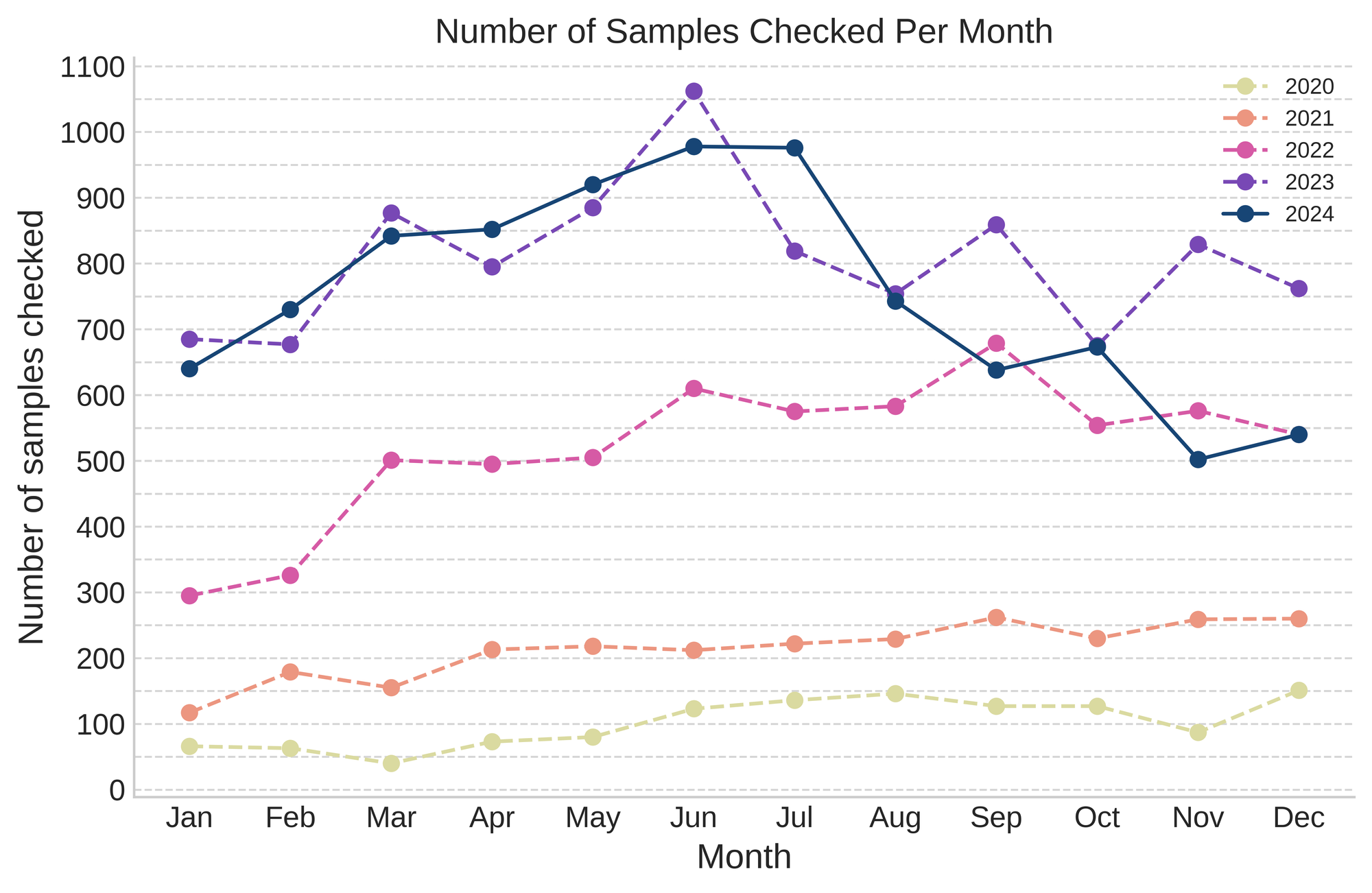
Sample Volumes Per Service Location
This year we continued to provide secondary analysis via paper spray mass spectrometry to our distributed sites located in overdose prevention sites operated by the Port Alberni Shelter Society, the Vancouver Island Mental Health Society in "Campbell River", Lookout Housing and Health Society in "Duncan", Island Health Mental Health and Substance Use in "Port Hardy", as well as AVI Health and Community Services in the "Comox Valley" and "Campbell River". At our point-of-care site in "Victoria", sample volumes decreased by 12.1%. However, this was not the case for our distributed sites in "Campbell River" and "Duncan", which had 47.8% and 49.6% increases in sample volumes respectively. During late 2023, we added an additional site in "Campbell River" which is one factor that could have lead to their increase in sample volumes. As for our distributed site in "Duncan", they were able to add an additional staff member to the floor of their overdose prevention site, which may have allowed them to more consistently check samples. Overall, across all service locations, we observed a 6.7% decrease in sample volumes compared to 2023.

Here in so-called "Victoria" our outreach program collects samples from various housing and supervised consumption sites. One goal of the outreach program is to help more people access drug checking, another goal is to create and nurture connections with community members and staff from other organizations. One way we maintain these connections is by sharing information about the local drug supply through our weekly reports (which were redesigned this year based on community feedback) and monthly reports, in addition to other resources made or maintained by Substance such as drug pamphlets and benzo equivalency charts. Another aspect of our outreach program are the teaching days we operate where anyone can learn more about drug checking and even how to use some of the instruments that we use to check drugs.
Teaching Days
Written by Lea Gozdzialski
“That’s so cool!”—a common phrase sung from within the little “red door room” around the corner from Substance. “What’s going on in here?” we are asked, as folks poke their head in, intrigued by the homemade sign, open door, and excitement heard from within. “Come on in, let me show you!”
In 2024, we hosted a weekly drop-in space where folks accessing drug checking were welcomed to try their hand at checking their own substances with an IR spectrometer, one of the instruments we use at Substance. “Teaching Thursdayz” was initially established as a step towards confronting the inequities in access to information and technology in drug checking by carving out a space for knowledge co-creation. The past year has seen many visitors, teachers, and learners engaged in teaching days. We have so much gratitude to all of those who have trusted us with their ideas, experiential knowledge, stories of joy and grief, frustrations, and questions. Whether nerding out on lasers and functional group chemistry, ranting about collective frustrations with the limitations of drug checking (and with the world), or celebrating “aha” moments, every interaction leaves us feeling deeply connected. We look forward to seeing you all at teaching days in 2025!
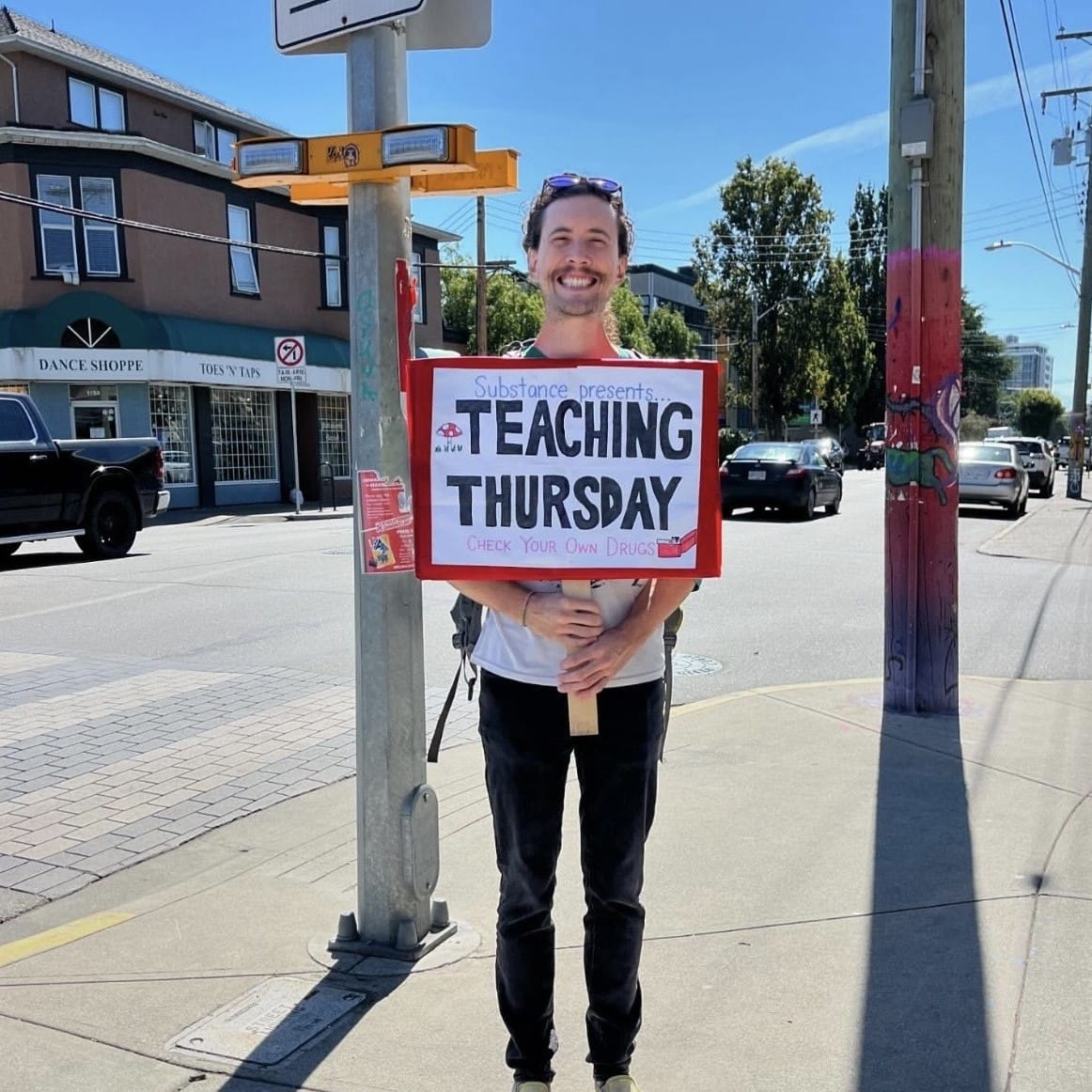
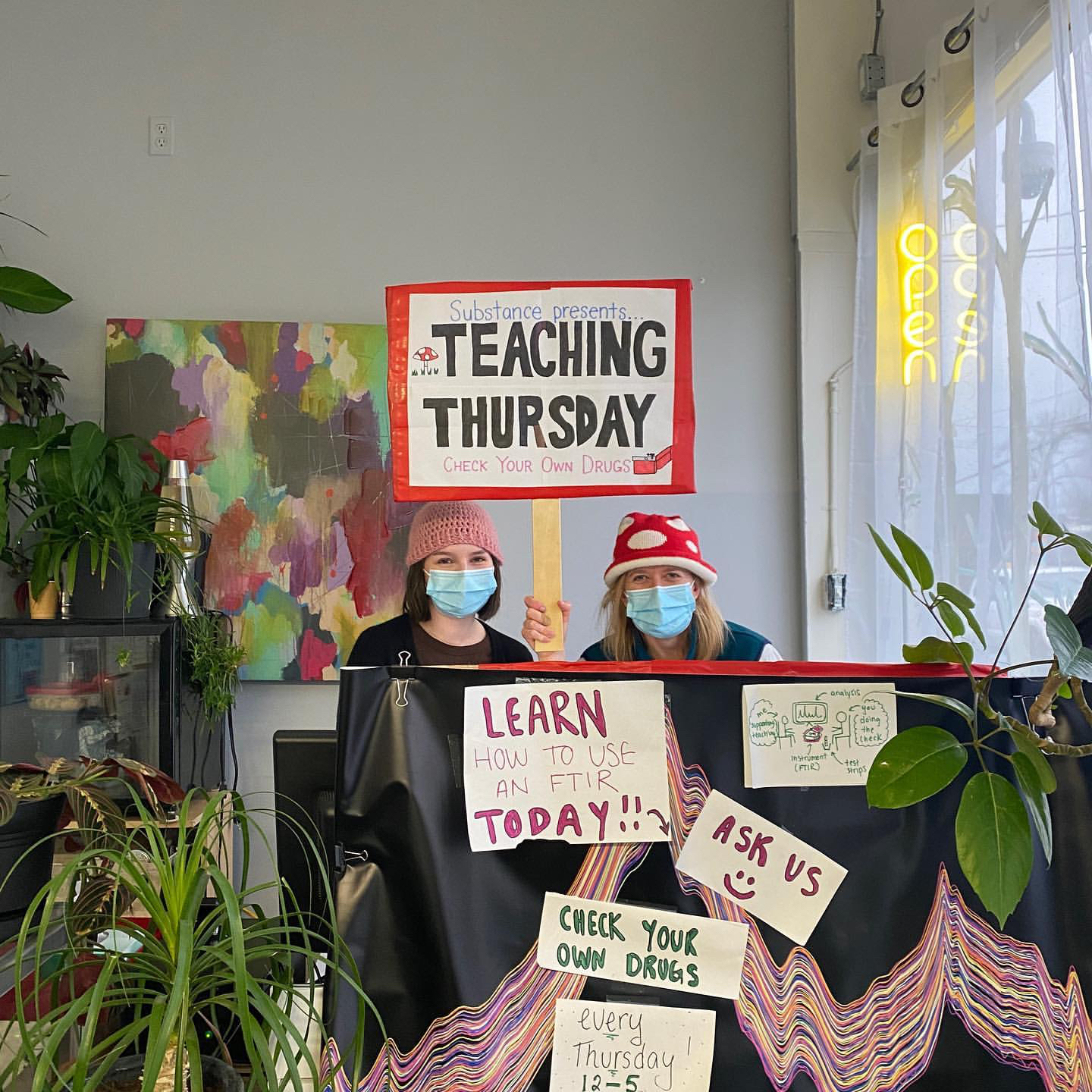
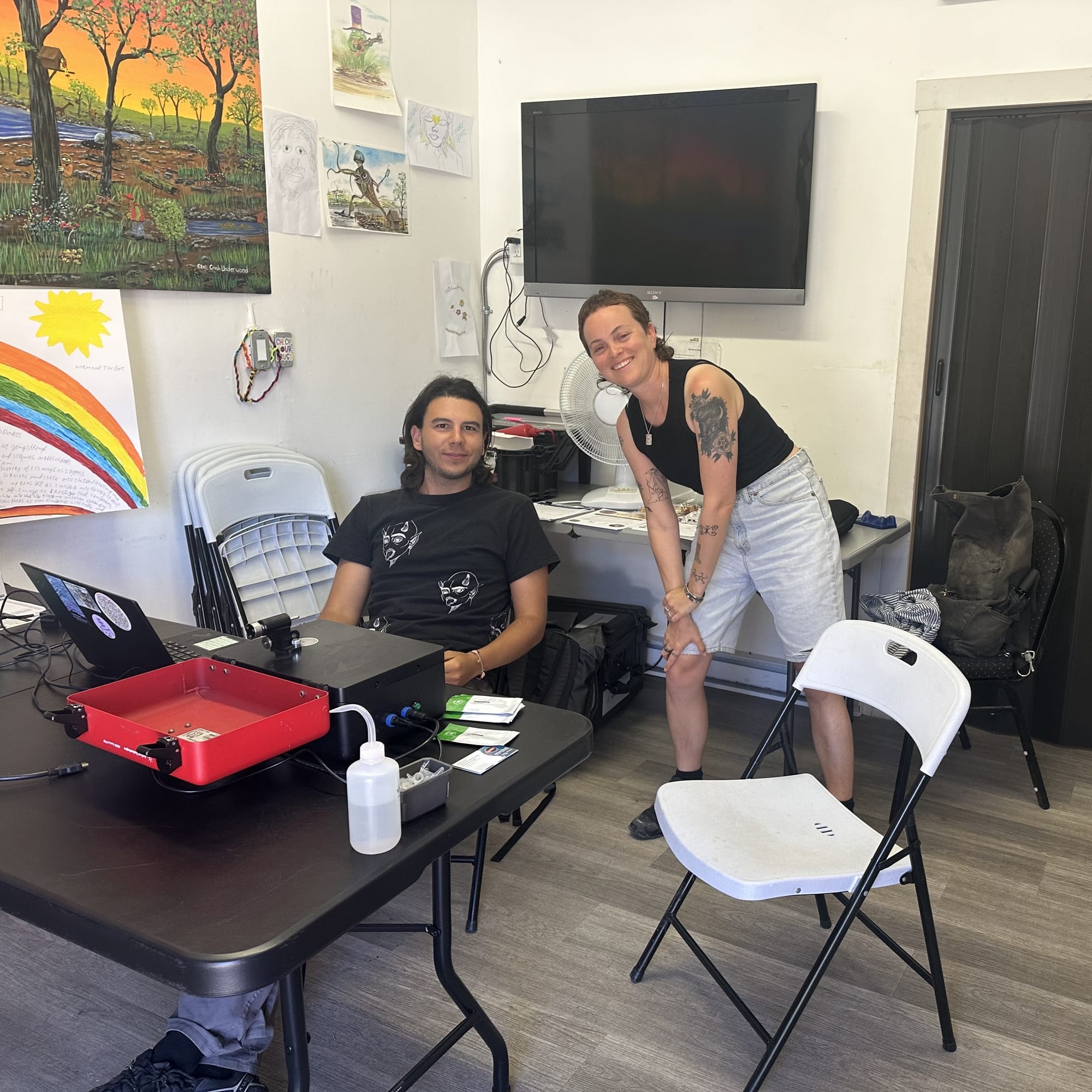
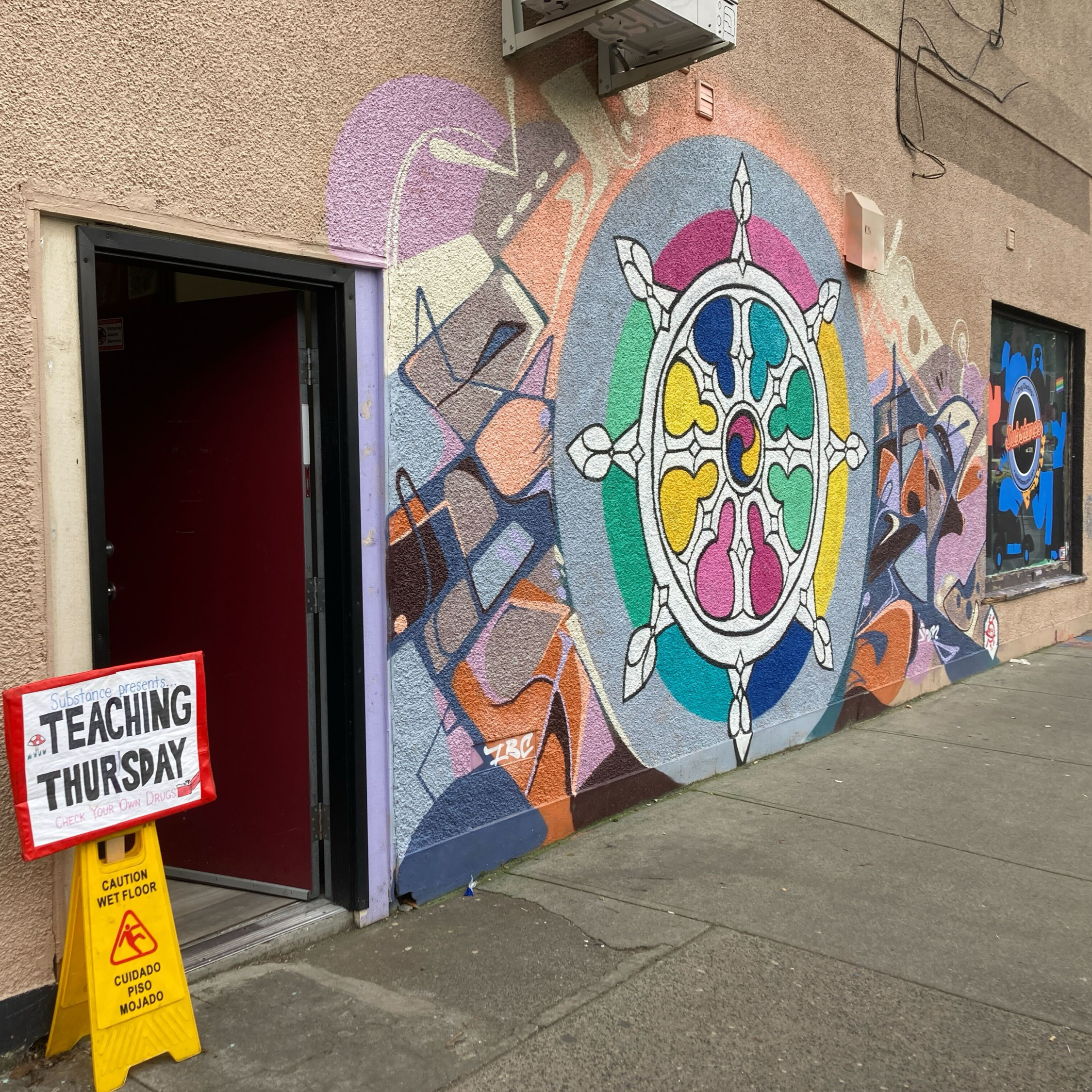
Some scenes from Teaching Days
Distributed Drug Checking Training Program
Written by Taylor Teal
2024 was a big year for training research and development at Substance! At the beginning of the year, we onboarded our newest and most northern site with the addition of Port Hardy Mental Health and Substance Use to the Distributed Drug Checking model. Training with new staff at other existing sites continued via our original training program until April of 2024, when we paused to focus on sharing what we learned from our research on the training, and to work on some exciting updates.
In September, we received confirmation that our article on the Distributed Drug Checking Training Program would be published in the Journal of Public Health Management and Practice. This article describes the results of evaluation research we conducted from May 2022 to March of 2024, including lessons learned and implications for practice. You can check out the article by visiting the research section of our webpage.
November saw the launch of our newly created, highly interactive eLearning, wherein the virtual curriculum of the distributed training was transformed into an asynchronous format. The goal of this shift was to make the training even more scalable and sustainable moving forward. The new multimedia-rich train- ing includes optional narration, captions, and many activities, with learning pathways for new and past distributed drug checking trainees. We’re happy to say that our first groups of learners have successfully completed the new training and we’re excited for its continued roll out in 2025!
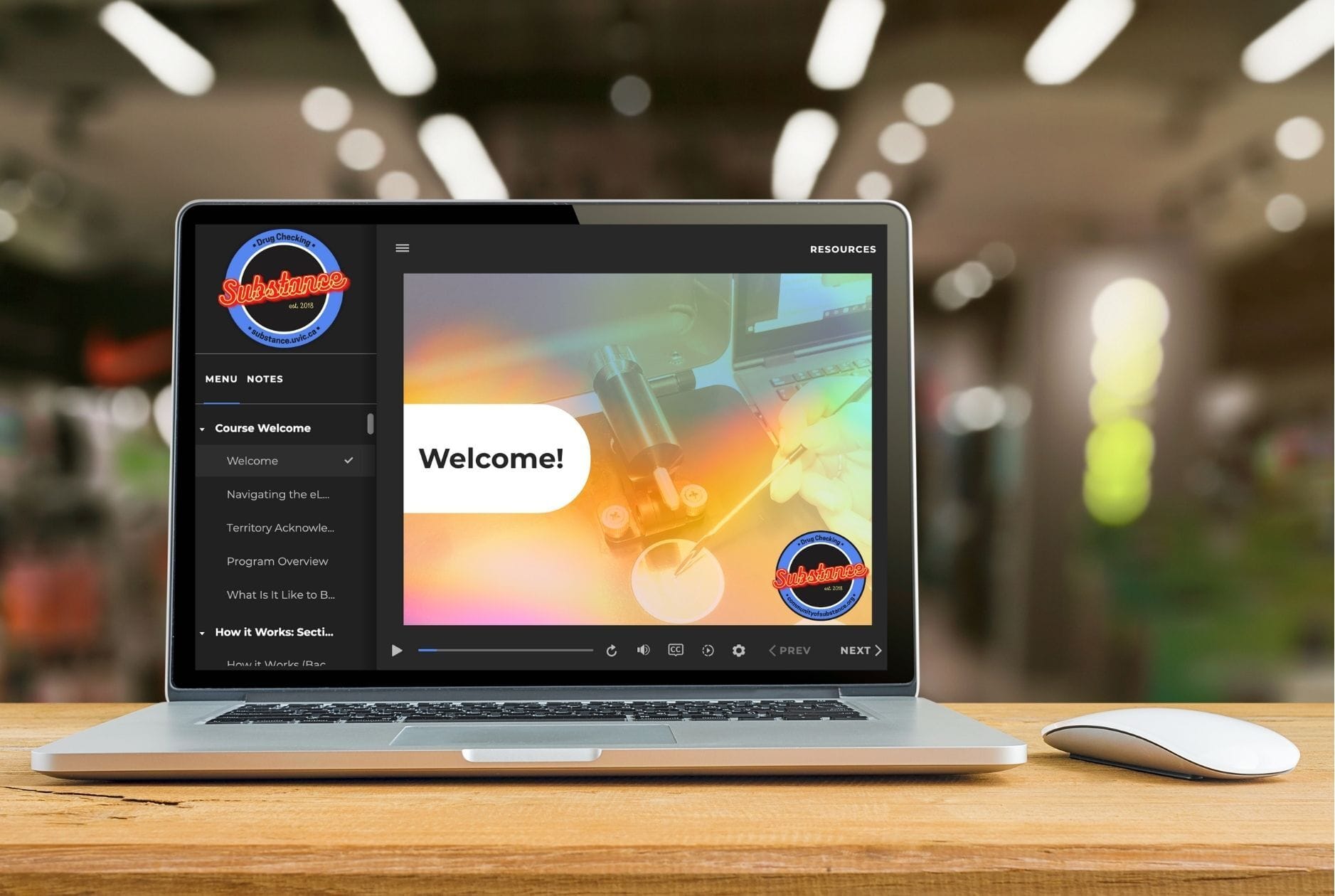
Event and Festival Drug Checking
In total, we operated drug checking at seven music festivals and two community events during the summer of 2024, referred to as “festival season” by some. At these gatherings, our services reached a total of 181 service users and provided valuable, potentially life saving information about the composition of 251 samples. The busiest event was Otherworld, Vancouver Island's regional burning man event, where we checked 115 samples for 78 unique Otherworldians (a.k.a. service users). The second busiest event was Samsara Music Festival where we checked 43 samples for 30 unique service users over the course of three days. Just shy of Samsara in terms of sample volume was Pachena Bay Music Festival, where we checked 39 samples for 29 unique service users. More information about the events and festivals we checked drugs at can be found below in Table 2.
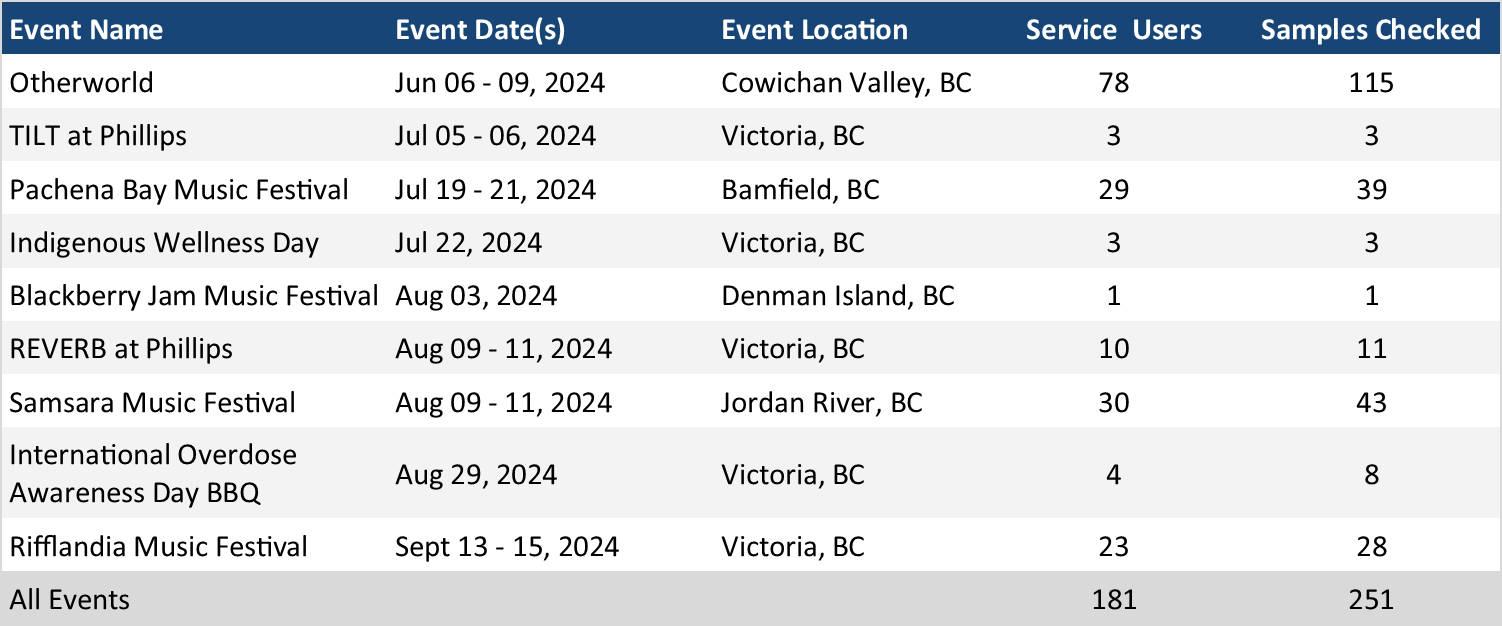
Drug checking at events also acts as a form of outreach by engaging people who are new to having their substances checked. As part of our intake survey, we ask whether or not a service user has accessed any drug checking service before. When looking at the data from the events this summer (Figure 2), we find that 51.4% (92/179) of service users who responded to the intake survey had not used a drug checking service before. When compared with data collected at our storefront in "Victoria", only 20.9% (233/1073) were new to drug checking. Suggesting that event based drug checking is a viable method to expand the reach and accessibility of drug checking, especially to new service users. For more information about event and festival drug checking, read our 2024 Event and Festival Report.
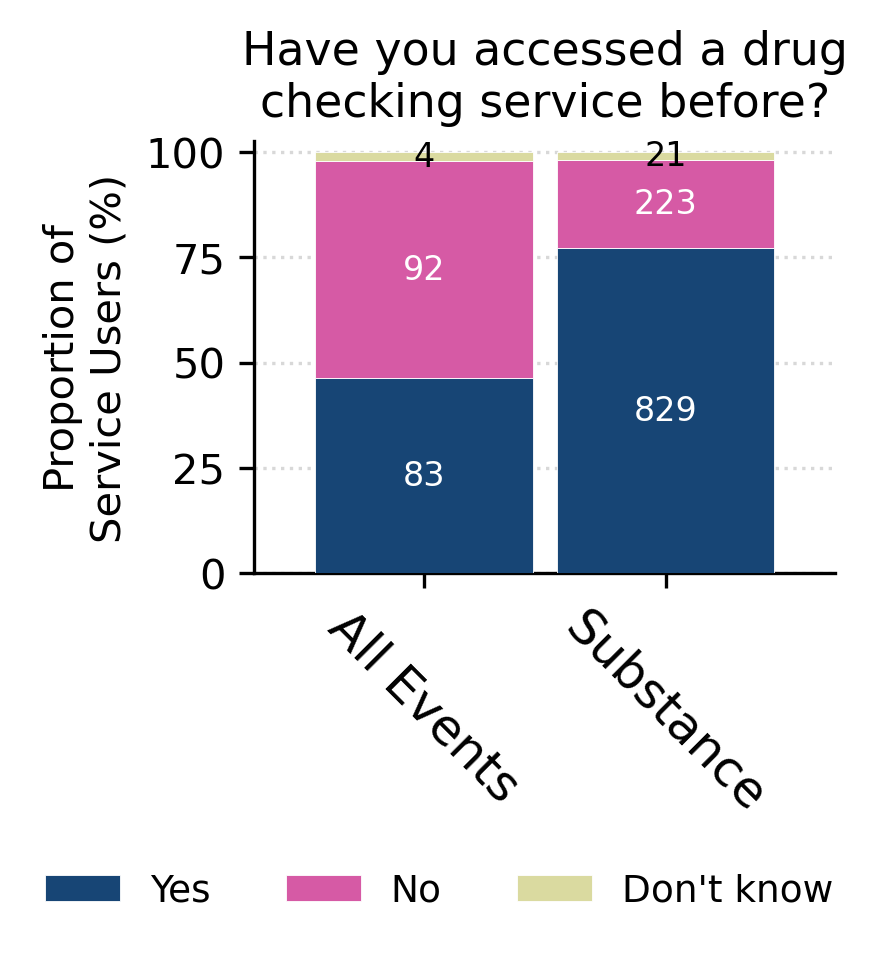
What were people bringing to get checked?
People bring us a wide variety of substances that can be grouped into different drug classes. The donut chart below aggregates the total number of samples we checked by their expected substance (i.e. the drug category reported by the service user), inclusive of all service locations. The consistent use of drug checking for a diverse range of drug categories, throughout the entire year, and across the island, demonstrates the continued need for both universal and population-targeted approaches to drug checking services and the accessibility of services.
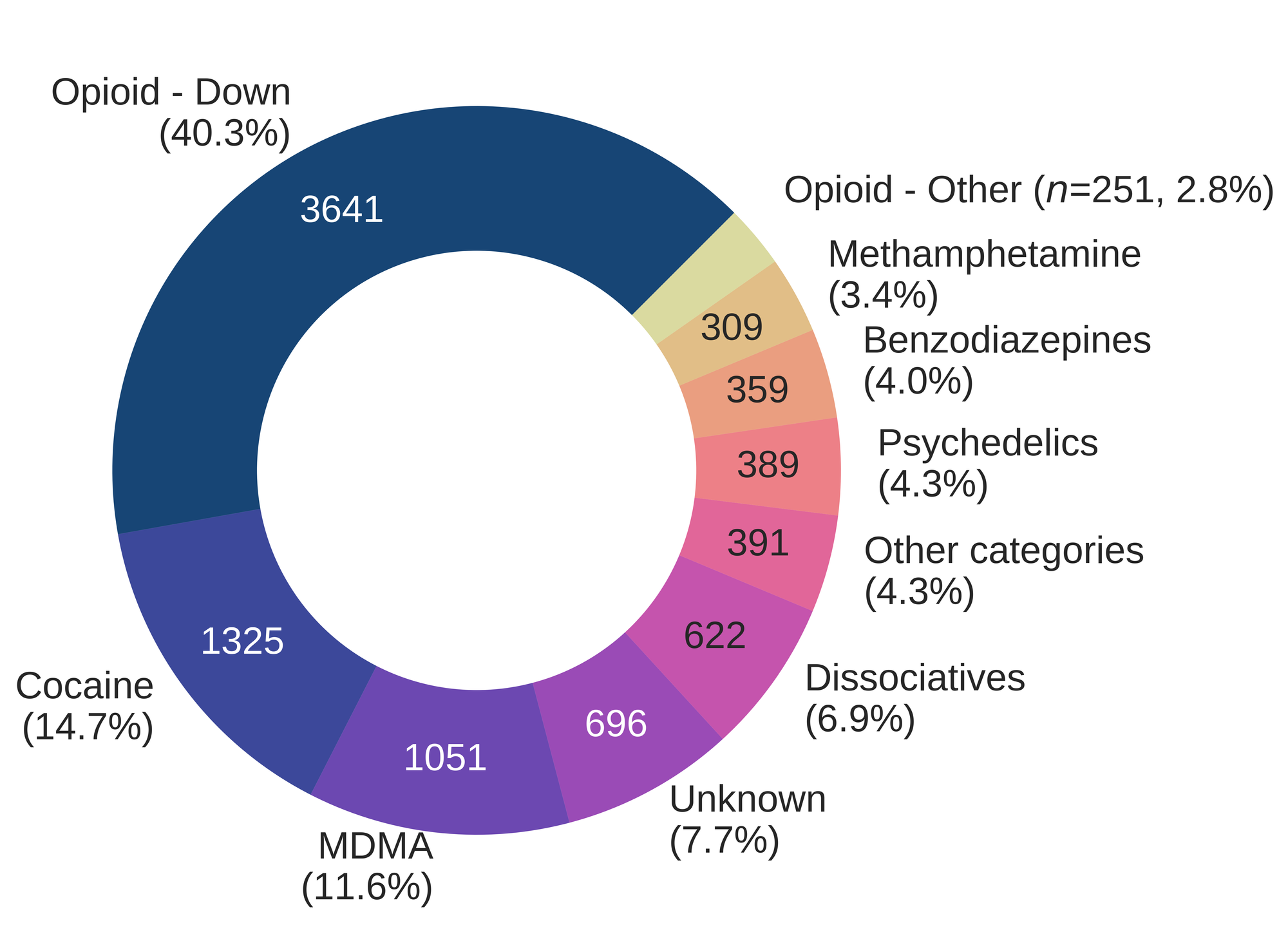
Some example [1] drugs within each class are as follows: Opioid - Down: fentanyl, ortho-Methyl fentanyl, and heroin. Cocaine: cocaine HCl (powder/soft), cocaine base (crack). MDMA: MDMA, MDA. Dissociatives: ketamine, novel dissociatives like O-PCE. Benzodiazepines: bromazolam, alprazolam (Xanax), diazepam (Valium), etizolam. Psychedelics: 2C-B, DMT, LSD. Opioid - Other: hydromorphone (Dilaudid), oxycodone. Other categories: 3-MMC, Adderall, methylpheni- date (Ritalin), GHB, quaaludes, cannabis products, steroids, novel “designer drugs.” Unknown: samples where the expected drug was not known by the service user.
This list is not comprehensive to every expected drug within each subcategory ↩︎
What were people getting checked by location?
The expected substance data presented in the previous section can be separated by sample collection location/method. Each site shows its own unique proportion of the types of samples checked, and these differences are based partially on the type of site that is offering drug checking (OPS vs. storefront), on community engagement with the service, and on the regional markets overall. Regardless of the type of service offering drug checking, drugs representing the full suite of drug classes are seen across Vancouver Island.
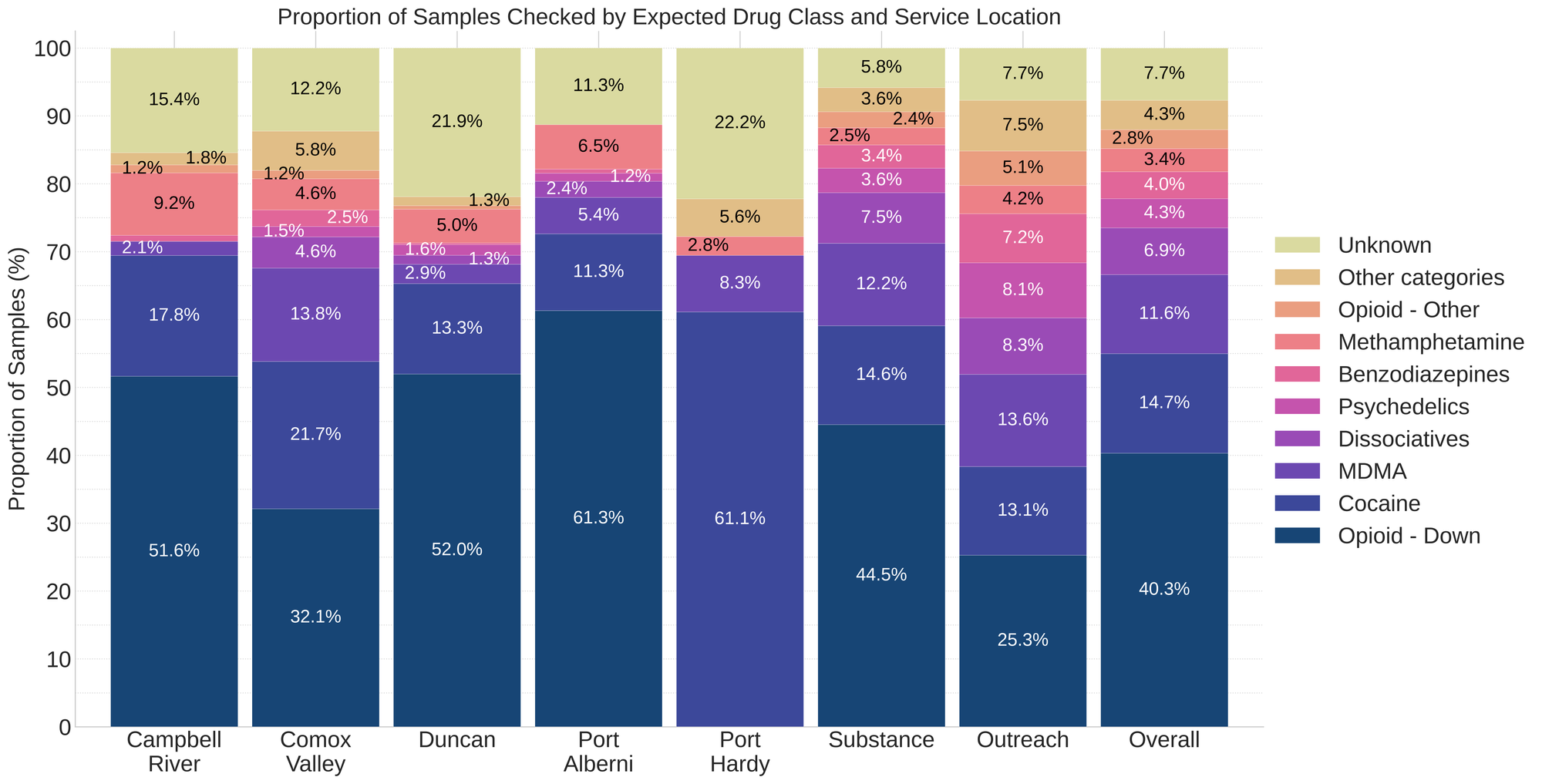
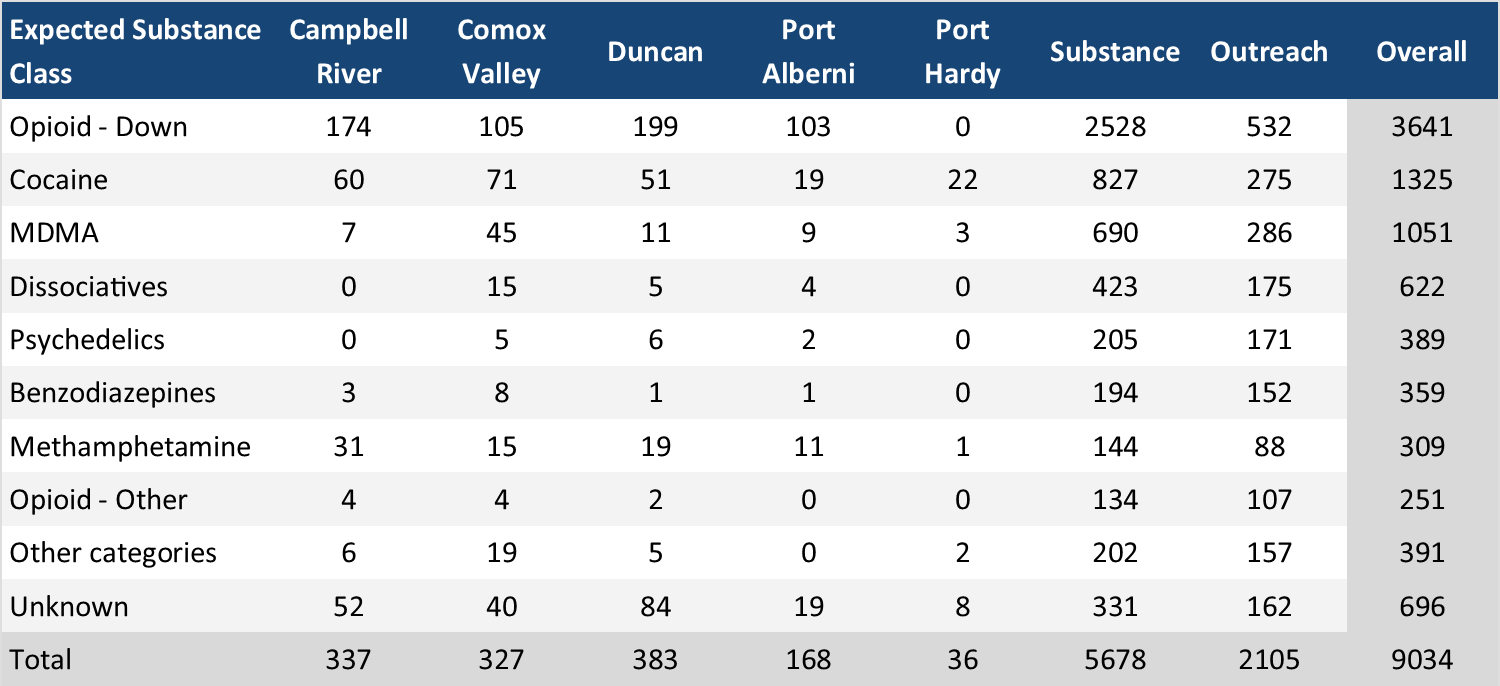
Full Report
If you'd like a full breakdown of what we found in each category of drugs, including the prevalence of active components and cutting agents, and quantification data please check out the full report below.
Want to be notified when we release these reports? Join our mailing list by clicking the button below. You'll receive updates about when our reports are available directly in your inbox. You can subscribe and unsubscribe from this list at any time.
